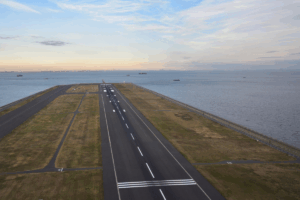Runway lighting systems are designed to reduce pilot uncertainty. They guide aircraft through low-visibility conditions, prevent runway incursions, and ensure safe, efficient takeoffs, landings, and ground movements
A critical component of any complete runway lighting system is the lighted wind cone. These high-tech units provide pilots with reliable, real-time information about surface wind direction and relative wind speed during approach, landing, and taxiing. Without them, you run the risk of crosswind landings, aborted takeoffs, and runway accidents.
How Do Runway Wind Cones Work?
The wind cone (also known as a wind sock) is a relatively simple piece of technology that’s composed of a fabric cone mounted on a pole with a swivel. The swivel allows the wind cone to rotate freely and align with the direction of the wind. For example, if the cone is pointing south, the wind is coming from the north.
The FAA AC 150/5345-27 allows for the wind sock to be white, yellow or orange, and color choice normally varies by region. For example, American airports typically use orange, while white is commonly used in Australia. Some airports use two-color wind socks, such as red and white, with the first, middle, and last stripes being the darker color.
Wind cones also provide wind speed indication to pilots by inflating to various degrees. Many wind socks are divided into five segments, with each segment representing a wind speed of approximately 3 knots (3.5 mph or 5.5 km/h) each. This means that if three segments are inflated, the wind speed can be estimated at 9 knots (10.5 mph or 16.5 km/h). Fully extended wind cones generally indicate a wind speed of 15 knots (17 mph, or 28 km/h) or more.
Typically, airports install at least one primary wind cone within or near a segmented circle adjacent to the runway midpoint. Many airports also install additional cones at each runway end.
One unique feature about windcones is that, unlike other parts of your system, they don’t rely on digital readouts, data transmissions, or software to operate. Their ability to provide an immediate point of reference unaffected by communication delays is why FAA and ICAO standards mandate their presence at airports of all sizes.
Using Lighted Wind Cones During Night Operations, Bad Weather, And Other Low-Visibility Conditions
Wind cones, just like any other part of your runway lighting system, are only effective if they’re visible. That’s why these devices require either internal or external illumination to ensure continuous visibility.
External Wind Cone Lights
This system is composed of floodlights or other light sources directed at the wind cone from the ground. Ground fixtures must be positioned to minimize glare that can distract or blind pilots. A minimum illumination of 2 foot-candles (fc) is required on the wind cone’s horizontal plane, ensuring that its upper surface remains well-lit throughout its rotation.
Internal Wind Cone Lights
These lights are located in the wind cone, making it glow to enhance visibility in low-light conditions. Internally lighted wind cones must be connected to a backup or redundant light source to ensure continuous illumination if a light source fails. They must maintain an average luminance of 10 to 30 foot-lamberts (fL), with a minimum of 2 fL at any point.
Airports with advanced lighting control and monitoring systems (ALCMS) can integrate wind cone lighting into the same supervisory network used for runway and taxiway lights. Many wind cones also feature adjustable brightness settings to adapt to fog, rain, or other low-visibility conditions that demand different levels of illumination.
As with many other runway lamps, most airports are moving away from incandescent or halogen bulbs toward light-emitting diode (LED) technology. LEDs are much more energy-efficient and longer-lasting than their predecessors, helping airport operators reduce their lamp maintenance, replacement, and energy costs. LED-lit wind cones are also more resistant to the vibrations and temperature fluctuations associated with use at airports.
Read More: Tips For Protecting Your Runway Lighting From Extreme Weather
Extending The Life Of Your Wind Cones
Wind cones are subject to various harsh environmental conditions, such as extreme winds, ice accumulation, sand erosion, UV exposure, and more. If the cone fabric fades, tears, or accumulates ice, its ability to provide accurate, reliable information is compromised. Similarly, lighting components must also withstand constant exposure without corroding or shorting out.
When commissioning new wind cones or upgrading existing ones, select devices that feature:
- High-strength, UV-resistant fabrics that resist tearing and retain visibility over years of wind, sun, temperature, and environmental exposure
- Sealed electrical housings and gaskets to prevent moisture from entering the fixture
- Anodized or powder-coated mounting hardware that resists corrosion
After the wind cone is installed, it will need to be routinely inspected for issues that can turn into severe problems down the road. For example, look for corrosion on the mounting pole, wire damage, and issues with the bulbs. There should also be no issues with the fabric, such as tears, fading, or other damage.
If you have any questions about wind cones, please contact the experts at Airport Lighting Company. We’re always happy to connect our customers with customized solutions that enhance their operations.
Read More: Our Products
Call Airport Lighting Company For The Latest In Airport Lighting Technology
The Airport Lighting Company team is standing by to answer your questions about how our tech-based products can help improve the safety, reliability, and efficiency of your runways. Call 315-682-6460 for fast, friendly service you can count on.


